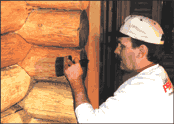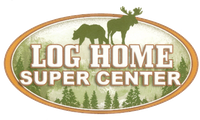STEP 3
Maintenance Guideline
for Lifeline Exterior
LifeLine Exterior combined with the acrylic top coat of LifeLine Advance is the ultimate exterior finish for your log home. Through many years of research, development and experience, Perma-Chink Systems has perfected a water-borne finish that provides the following benefits to you:
- LifeLine Exterior is the best looking finish that you can find. It distinguishes your house from the ordinary. It highlights grain and texture to bring out the natural beauty of your wood. Compare it to any finish you can find.
- LifeLine Exterior encases the surface fibers of wood to put its protection at the surface where the protection is needed. LifeLine is a flexible coating that moves with seasonal expansion and shrinking of the wood.
- Pigments are an important component in protection or your valuable wood. UV inhibitors extend the life of the finish itself, but it is the pigments that provide the long term protection against UV, while highlighting wood grain. The 2 coats of LifeLine Exterior contain these pigments.
As the finish wears off, the pigments weather away at the same time. Then, as maintenance coats are applied, you avoid the buildup of pigments that happens with conventional exterior finishes.
The result: your house still looks as good after years of maintenance as the first time that you finished it.
Conventional exterior finishes build up layer after layer of pigments on the wood, making your house darker each time you apply another maintenance coat. The LifeLine system gives you the choice during maintenance coats to use pigmented LifeLine Exterior or clear Lifeline Advance.
LifeLine Exterior breathes to allow your wood to dry naturally, while protecting the wood from additional moisture from rain.
LifeLine Exterior is easy to apply and to work with. It releases no toxic fumes and is not flammable. It cleans up with soap and water.
How to Maintain Your LifeLine Exterior Finish
 Initial application of LifeLine Exterior is a properly applied coat of pigmented
LifeLine EXterior wood finish (350-450 sq. ft.. per gallon); a second coat
is optional to even the color throughout the log wall if needed (600-800 sq.
ft. per gallon).
Initial application of LifeLine Exterior is a properly applied coat of pigmented
LifeLine EXterior wood finish (350-450 sq. ft.. per gallon); a second coat
is optional to even the color throughout the log wall if needed (600-800 sq.
ft. per gallon).
Twelve to eighteen months later, apply an additional thin coat of Lifeline Advance. This coat should also be applied at a nominal 1000 sq. ft. per gallon.
After this application of Lifeline Advance, your exterior should require little maintenance for a period for at least 3 to 5 years. If local weather conditions are severe, or if moisture content of logs is high (over 20%), then additional maintenance may be required.
Cleaning
Cleaning your exterior walls is an important step in maintaining appearance and durability of your finish. Exterior surfaces of the house are a setting ground for dust, pollens and other airborne contaminants which dull the surfaces and provide food for fungal growth. Cleaning is also a necessary step prior to performing adequate inspection of the condition of your exterior finishes.
When you clean your exterior walls,
always be careful to do it in ways that cause the least harm to your finishes.
Do this by:
- Always using mild solutions of cleaners on the wall.
- Strong cleaners may damage your finish! If in doubt, try your solution in an inconspicuous area before proceeding.
- Always using a mist setting on water nozzles, not a jet.
- Always using soft bristled brushes or non-abrasive pads for cleaning.
The most efficient way to clean your house is to use a dilute soap and water solution. If there are stubborn stains or mildew and mold stains, some household chlorine bleach added to your cleaning solution will probably help out. (Never use household bleach stronger than 25% solution in water.)
Note: We advise you never to use chlorine bleach on bare wood. The above discussion applies to stubborn stains on finished wood. Chlorine bleach is caustic and is hard on wood and wood finishes. Exercise caution by using mild cleaning solutions and rinsing thoroughly.
- Mist
the wall with your garden hose.
Work on an area only big enough that the cleaning solutions are on the wall for about 5 to 15 minutes. - Using the brush or sponge, apply the cleaning solution from the bottom up.
- After gentle scrubbing, thoroughly wash the cleaning solutions off the wall with plenty of mist from your garden hose.
- Be sure to fully rinse the solutions off the wall, because residue from some cleaners is conducive to fungal growth.
Remember to wash from the bottom up, rinse from the top down.
What to expect.
The exterior finish is expected to do a lot. It is expected to protect your walls from the damaging effects of heat, wind, rain, and sunlight. The effects of these elements happen at different rates on different parts of your house. All things being equal, south and west facing walls (which normally receive more sunlight and heat exposure) weather more quickly than north and east facing walls.
Walls protected by deep roof overhangs weather slower. Any wood surface that is exposed to repeated wet/dry cycles will weather quicker than areas protected from water damage. Log ends should be carefully inspected and maintained. Log end grains absorb water at about 10 times the rate as longitudinal grain. Keep log ends protected to prevent the problems associated with wood mold, mildew, rot and insect infestation. Also be aware of sap bleeding out of logs during the first years of seasoning. Finishes cannot prevent or control sap bleed.
Over time, checks or cracks open
up in log wall surfaces. As this happens, it exposes new wood to moisture
brought in by rain. Then, the water-soaked wood will swell and shrink more
than protected wood. Therefore it is important to seal any upward facing checks
that are greater than 1/4 inch wide if they are exposed to blowing rain or
other water sources.
Go to STEP 4 to get more information on our log home sealant application guide.
